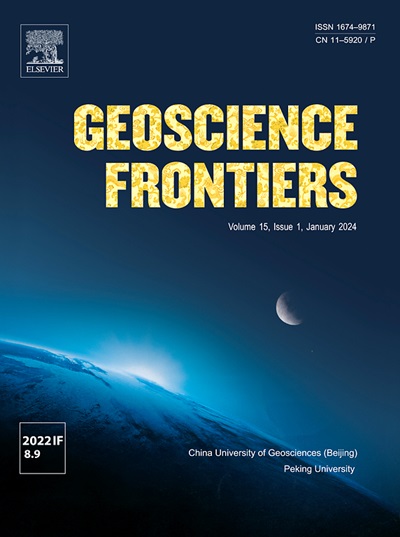Unravelling the geochemical and geochronological diversities of the pre-collisional magmatism: Implications for the subduction dynamics in the Kohistan island arc and Karakorum block, Pakistan
IF 8.5
1区 地球科学
Q1 GEOSCIENCES, MULTIDISCIPLINARY
引用次数: 0
Abstract
The magmatic arcs in the north-west region of Pakistan comprises of numerous volcanic and plutonic bodies of different ages and compositions evolved during the subduction of the Neo- Tethys Ocean under the Eurasian supercontinent. This study focusses on the examination of the granitoids of the Kohistan batholith (a part of Kohistan-Ladakh Island Arc; KLIA) and the Khunjerab pluton, concentrating on their petrological traits, mineral chemistry, in-situ zircon U-Pb geochronology, and whole-rock major and trace element geochemistry. According to zircon U-Pb dating, the Kohistan batholith granitoid was emplaced around 91.7 ± 0.3 Ma, while zircons of the Khunjerab pluton yield ages of 106.4 ± 0.4 Ma and 106.4 ± 1.0 Ma. All the samples from both magmatic units have calcic to calc-alkaline (Na2O + K2O: 3.6–10.6 wt.% and SiO2: 60–73 wt.%), metaluminous to peraluminous properties (Aluminum Saturation Index (ASI): 0.9–1.2). Notably, Nb, Ta, and Ti show depletion, while large ion lithophile elements like Cs, Rb, and K have been enriched. Additionally, we find that SiO2 and P2O5 have a negative correlation while Rb and Th have a positive correlation, which confirm an I-type arc magmatism. Together with the published literature, TEM analysis, and thermal modelling, our zircon U-Pb results point to a period of continuous magmatic activity from the Late Jurassic to the Late Cretaceous (between 150 Ma and 91 Ma) in the Kohistan Island arc region while the Khunjerab pluton (part of Karakorum block/Eurasian plate) experienced widespread magmatism around 120 Ma to 106 Ma. With SiO2 concentrations ranging from 67.5–73.3 wt.% and 60–71.4 wt.% and relatively low alkali (Na2O + K2O) contents between 3.6–10.6 wt.% and 5.1–7.4 wt.% in the Kohistan batholith and Khunjerab pluton respectively, showing clear signs of acidity. The whole rock as well as the mineral geochemical analysis and the elevated water contents (8–10 wt.% and 3.1–3.5 wt.%) inferred from amphibole and biotite chemistry respectively, indicates that the Kohistan batholith was most likely formed through partial melting of a (hydrous) magma originating from a more or less altered metasomatized mantle wedge. Likewise, the Khunjerab pluton whole rock geochemistry also indicates its origin through partial melting of magma originating from an altered metasomatized mantle wedge. This study also shows that both units are not only different in terms of the nature of magmatism but also in terms of their ages i.e., continental arc magmatism occurred in the Khunjerab (Karakoram) block in the middle Cretaceous (106 Ma) while island arc magmatism occurred on the Kohistan side in the late Cretaceous (91 Ma). Further, this study also investigate why multi-grain U-Pb zircon dating is necessary for studying magmatic rocks by using transmission electron microscopy.

揭示碰撞前岩浆活动的地球化学和年代学多样性:对巴基斯坦Kohistan岛弧和Karakorum地块俯冲动力学的影响
巴基斯坦西北地区的岩浆弧由许多不同年龄和成分的火山和深成体组成,这些岩浆弧是在欧亚超大陆下新特提斯洋俯冲过程中形成的。本文重点研究了科希斯坦基(科希斯坦-拉达克岛弧的一部分)的花岗岩类;研究了它们的岩石学特征、矿物化学特征、原位锆石U-Pb年代学特征和全岩主微量元素地球化学特征。锆石U-Pb定年结果表明,科希斯坦岩体花岗岩的侵位年龄约为91.7±0.3 Ma,而红其拉普岩体的锆石侵位年龄分别为106.4±0.4 Ma和106.4±1.0 Ma。来自两个岩浆单元的所有样品均具有钙-钙碱性(Na2O + K2O: 3.6-10.6 wt.%, SiO2: 60-73 wt.%),铝质-过铝质性质(铝饱和指数(ASI): 0.9-1.2)。值得注意的是,Nb、Ta、Ti呈亏缺状态,而Cs、Rb、K等大离子亲石元素呈富集状态。SiO2与P2O5呈负相关,Rb与Th呈正相关,表明岩浆活动为i型弧岩浆活动。结合已发表的文献、TEM分析和热模拟,我们的锆石U-Pb结果表明,在晚侏罗世至晚白垩世(150 ~ 91 Ma)期间,Kohistan岛弧地区存在持续的岩浆活动,而Khunjerab岩体(喀喇昆仑块体/欧亚板块的一部分)在120 ~ 106 Ma期间经历了广泛的岩浆活动。Kohistan岩基和Khunjerab岩体的SiO2含量分别为67.5 ~ 73.3 wt.%和60 ~ 71.4 wt.%,碱(Na2O + K2O)含量相对较低,分别为3.6 ~ 10.6 wt.%和5.1 ~ 7.4 wt.%,具有明显的酸性特征。整体岩石、矿物地球化学分析以及角闪孔和黑云母化学测定的高含水量(8-10 wt.%和3.1-3.5 wt.%)表明,科希斯坦基极有可能是由源自或多或少蚀变交代地幔楔的(含水)岩浆部分熔融形成的。红其拉甫岩体的整体岩石地球化学特征也表明,红其拉甫岩体的成因是源自变质地幔楔的岩浆部分熔融。研究还表明,两个单元不仅岩浆活动的性质不同,而且岩浆活动的时代也不同,即红其拉甫(喀喇昆仑)地块在中白垩世(106 Ma)发生了大陆弧岩浆活动,而科希斯坦一侧在晚白垩世(91 Ma)发生了岛弧岩浆活动。此外,本文还探讨了多粒U-Pb锆石定年在岩浆岩透射电镜研究中的必要性。
本文章由计算机程序翻译,如有差异,请以英文原文为准。
求助全文
约1分钟内获得全文
求助全文
来源期刊

Geoscience frontiers
Earth and Planetary Sciences-General Earth and Planetary Sciences
CiteScore
17.80
自引率
3.40%
发文量
147
审稿时长
35 days
期刊介绍:
Geoscience Frontiers (GSF) is the Journal of China University of Geosciences (Beijing) and Peking University. It publishes peer-reviewed research articles and reviews in interdisciplinary fields of Earth and Planetary Sciences. GSF covers various research areas including petrology and geochemistry, lithospheric architecture and mantle dynamics, global tectonics, economic geology and fuel exploration, geophysics, stratigraphy and paleontology, environmental and engineering geology, astrogeology, and the nexus of resources-energy-emissions-climate under Sustainable Development Goals. The journal aims to bridge innovative, provocative, and challenging concepts and models in these fields, providing insights on correlations and evolution.
 求助内容:
求助内容: 应助结果提醒方式:
应助结果提醒方式:


